|
|
|
| Dynaflite Skeeter |
| Left fuselage - wing combination is 10-1/4 ounces. Hitec Focus
II receiver, 110 mah battery and FMA S-90 servos Right fuselage has been strengthened for slope flying (retired in favor of Zagi). Right fuselage - wing combination is 13 ounces. Hitec Focus II receiver, 110 mah battery and Hitec HS-80 servos. Wing is covered with Mica film. |
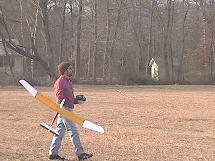 |
| About a year later I rebuilt and recovered the wing. Flying
weight was about 11 ounces. A second Skeeter wing was built (red) and used mostly with an Aspen Leaf fuse. |
| Skeeter Fuse #3 finished October, 2000 |
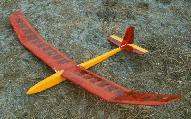 |
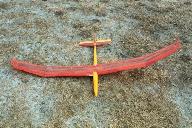 |
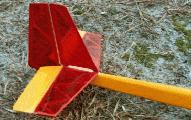 |
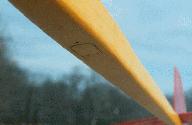 |
|
|
|
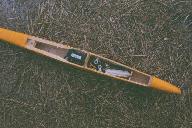 |
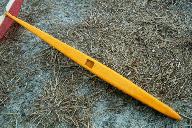 |
|
|
|
 |
| This skeeter fuse was built with what I had on hand using the plans
that came with the original Dynaflite kit. I selected the lightest
balsa I had and used Hitec HS-80 servos and a Hitec Flash II receiver, with
a 110mah battery pack. I could have used FMA S-80 servos to save another
1/2 ounce. Removing the case from the receiver would have cut another
1/4 ounce. No nose ballast was needed to put the CG 3/16" behind the
wing spar.
wing - 4 ounces The wing shown (wing #2) was involved in two mid-airs last year and is not in great shape. It is now being repaired and recovered. The tail was covered with Monokote transparent red. The fuse is painted with water based acrylic and a couple of coats of clear water based polyurathane (Varathane). |
| Building a light Skeeter - If you want a light skeeter you have to replace the heavy balsa in the kit and construct a built-up tail. If this is your first HLG, you would probably want to cover the entire fuse body with 3/4 ounce fiberglass with a second layer of fiberglass on the nose. Fuse: I used 1/16" fuse sides with 1/16" fuse doublers. Reinforce all former glue surface with 1/8 square balsa strips around the formers where the fuse sides and the formers meet, front and back of the formers. The front fuse former can be glued to the front of the fuse sides rather than between the fuse sides. This narrows the front of the fuse. If you've built a ligtht tail and don't need a large battery for balance, a 110mah battery fits. The new 270mah NIMH batteries are the same size and weight as the 110 NICD's. Don't build a split rudder per the plans. See my fuse #3 for the tail design. Cover the nose with fiberglass past the front former. Just CA the fiberglas on spreading the CA as you go. Put all radio gear ahead of the wing as far forward as possible. FMA s-80 servos will fit across the fuse if you cut off the mounting tabs. Don't cover the fuse. Use acrylic paint with a layer of polyurethane on top to seal. A pod and boom fuse like in the Terminator plans on the CharlesRiver site is even lighter. Wing: You can cut lightening holes in the ribs, but don't overdue it. The die-chopped ribs will probably have to be sanded to match. The stock wing span is only about 54". Increase the span to 59" by adding either tape-on wingtips or by extending the tips to begin with. Remember that because of the polyhedral, you will have to increase each tip about 3 inches. If you run the spruce spar caps out to the tips you can later use the wing in a discus HLG. If there is any possibility that you will discus launch this wing, put 1/4" wide strips of .007 thick carbon fiber on the top and botom of the spar before covering. Cover with transparent monocote (I like red) for strength. Nine and a half ounces RTF is not unreasonable. Good luck and good thermals, John |
| Skeeter 400 Finished February 2001 |
Click on image to see full size photo
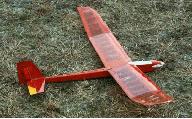 |
Skeeter 400 weighs 17.25 ounces. |
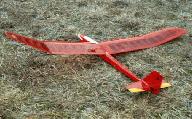 |
Hitec Focus III receiver, FMA s-80 servos, FMA 20 esc |
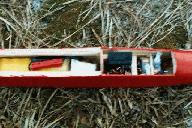 |
Battery (7x600mah) installs from top; notice EPP crash protection. |
| The 400 fuse shown is the second one I built. The first 400 fuse
was converted from #2 Skeeter fuse and wound up in many pieces after
a crash. Both wings shown on this page (red wing and yellow-white wing) are interchangeable between my two skeeter fuses, the 400 fuse, and my two Aspen Leaf fuses. Wing#1 (yellow white) weighs five ounces. Wing#2 (red) weighs four ounces |
| In the spring of 2003, I converted the yellow #3 Skeeter glider fuse (above) to electric.
The tail was built so light that the the servos had to be mounted behind the trailing edge of the wing - behind the battery pack - to get the cg in range. No nose ballast was necessary. The motor is angled 5 degrees down and about 2 degrees to the right. The nose was sawed off to get this motor angle. It could actually use more down offset. A plywood motormount was made and glued to the front of the fuselage. Two holes were placed in the cowling and space is left around the motor to allow cooling air flow. |
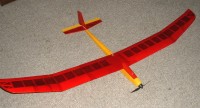 |
Skeeter 400 #2 weighs 17.5 ounces. Battery (7x500mah Nicad) installs from top |
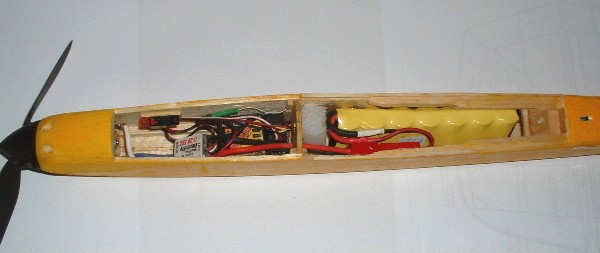 |
Hitec 555 receiver, Hs-55 servos, Great Planes C-20 esc |











